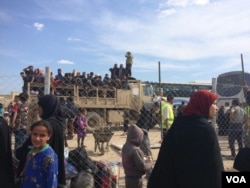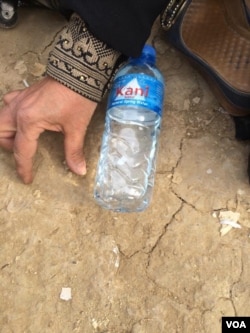“We tried to run the day before yesterday,” says 28-year-old Ammar Hazzim outside a refugee camp Sunday near Mosul. “But Islamic State militants executed 21 people that day for fleeing, including women.”
“Today, we decided we had to go,” Hazzim adds.
The past month in his neighborhood, New Mosul, he says has been a barrage of violence, including an airstrike that killed his brother and his three children 40 days ago.
Hazzim’s family and several others also describe a round of airstrikes about 10 days ago authorities say may have killed more than 100 people and prompted the U.S.-led coalition to launch an investigation into civilian deaths.
On Sunday, journalists were banned from New Mosul for the second day. But like other families fleeing western Mosul this week, Ammar’s family says that bombing is one of many airstrikes, car bombings, executions and suicide attacks that has turned New Mosul, or Mosul Jadida, and surrounding areas into a disaster zone.
“The militants gather families into small areas,” adds his brother, Lazem Hazzim, a father of three. “The families hide in the basements and the airplanes don’t see them. They are hidden.”
“In western Mosul, there is no place to strike without hitting families,” says Ammar.
Horrors as they run
Those able to run from New Mosul and nearby areas describe seeing entire blocks flattened and bodies of civilians scattered on the ground.
On Saturday in another area of Mosul, soldiers show cell phone video of them helping families escape, pointing out two primly dressed little girls.
In the next clip, their small bodies lie on the dirt road, shot by sniper fire.
Across a dirt road outside the camp, Haifa Hamid, a grandmother of eight, waits for a government bus to take them someplace safe -- in her case, a relative’s home. Her neighbors, a family of 26, were killed when their house collapsed on them, but it wasn’t the dramatic airstrike coalition forces are investigating
“Militants are fighting from our rooftops,” she says, sitting in the dirt with her children and grandchildren. “But they also have smashed holes in the walls of neighboring houses, so they can shoot from the rooftops and be in a different house before an airstrike hits.”
Darker times to come
In recent weeks, as Iraqi forces come closer to re-taking Mosul, many people have been forced to move back with IS militants, serving as “human shields.”
Densely populated areas now on the frontlines behind IS are becoming more crowded and the civilian death toll is unknown. But it is hard to find anyone among the refugees who hasn’t buried their dead in gardens recently.
Other bodies, says Mahmoud, 30, remain in the rubble as local authorities slowly dig them out. Some families are still believed to be alive, underground.
But for those that cannot get away, IS-forced moves appear to be strategic, says Hamid, the grandmother. Many families are ordered to go to a specific part of Mosul that Iraqi forces believe to be the heart of IS’s “true” believers in Iraq.
“I don’t know what they are planning,” says Hamid. “But everyone is afraid there is something in that.”
Hamid’s four brothers all live in the area, and she says civilians are as terrified of the “liberation” as they are of IS.
“With so many civilians dying in New Mosul, what will be their strategy there?" she asks. "They think it’s the home of IS.”















